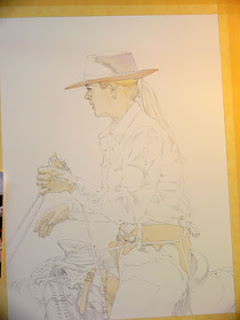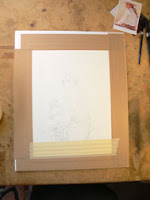I have a good art friend who is frustrated. He’s climbed several rungs of the art ladder and now finds things getting difficult. Let’s get one thing straight. This economy is tough. As if being a full-time artist isn’t enough to deal with, now the economy is throwing punches. Marketing art is different for every artist, and the process won’t be the same for any two. We all develop unique ways to sell and market art, and to my way of thinking, you need to be doing them all to keep the canoe upright and facing forward.
Marketing artwork is a horse of many colors: outdoor art shows, box shows, museum shows, websites, galleries, commissions, direct mail, thank you notes, referrals, email and much more. You’ve spent time, effort and money to gain the necessary skill level, painted it and framed it. Now the hard work begins. As artists, we must move in and out of all these marketing venues and master as many as possible.
Many beginning artists are of the opinion that a gallery or a specific show will make their career. It won’t. The same holds true for magazine editorials. When you’re first starting out, that elusive press just can’t be found. They won’t give us a break when we need it. But once we’ve had some success they generally become interested.
So one thing you need to know is that these avenues don’t always come at the right times. When it comes to your early career, it’s got to be you! What does this mean? Don’t be reactive. Waiting for the ultimate gallery to call, or acceptance by a top-flight show might take awhile. But, as I said, these little victories will come if you persist.
Today’s post is about “the meantime”. In the meantime, you must take your marketing efforts by the horns. What are some things you can do? Here are several ideas to get you started.
These eight ideas are foundational and basic. If you’re not doing these, then you’re not mastering basics, which means you’re not trying to be a pro. (If you’re not sure what this means, then go back and re-read my post on “The War of Art”.) Get these eight skills covered and you’ll be well on your way.
Starting with #8: Thank You Notes. Get one of your images printed on a thank you card and send them after every sale. No single act will endear you to your customer and work for referrals than handwriting a “thank you”. I send them religiously and they continue to pay off.
#7: Newsletter. Whether printed or email generated, both are effective. People are generally interested in what you’re doing and your process. They want to know where you’re going and where they can see you next. Don’t discount the power of staying connected with your friends and customers.
#6. Pre-mailing images. Send your customers a one-page flyer of your recent work. Buying artwork is a visual process. Give them something visual. I always send a flyer of available paintings prior to attending a show. You’ll be shocked when they come to visit because one particular painting is speaking to them.
#5. Email. You have the ability to direct mail your entire list of friends and customers from your studio. No direct mail printing cost, no stamps, no middleman. Send them images and prices. Never ever spam your list. And don’t add someone to your list who didn’t request it.
 |
Try dazzleprinting.com or
4over.com |
#4. Business Cards. This is one of the most overlooked and under-appreciated arrows in your quiver. I have a sculptor friend, who is very good, but his card is black and white and has the word “sculptor” printed on it. For a small cost increase, you can have a four-color image of your product, so your customer can see what you can do. If you’ve got a badass card, it will never get thrown in the round file. Here’s my card:
#3. Website. No excuses for a less-than-spectacular website. There are many good templates that allow you to move paintings in and out of your gallery pages. Change your images often and photograph all your work. Nothing says I’m a professional like good work on a great website. Try bludomain.com.
#2. Mailing List. Next to the upcoming #1 spot, nothing, and I mean nothing, is more important to your success than your mailing list. Guard it with your life. If you take care of your list, it will take care of you. Make sure you ask for everything…. Address, phone, email and the dog’s name, if you can get it. The customers will start out as customers, but they will become so much more. Some prefer to keep you at arm’s length and are only interested in collecting your work. Others will treat you like family. Reciprocate. They collect your work, initially, because they like your work. But if they like you they will continue to purchase paintings. Pam and I work at making friendships with our customers. And we have been rewarded with people who have become good friends and we consider them family. They are some of the most interesting and stimulating people we have met. (Some of them even bless you with a saddle chair for your studio).
#1. Paint good paintings. Nothing will do more to launch you down a successful art path like exceptional work. Do work that is so mind-blowingly good that the galleries will begin calling and the acceptance letters for the shows will begin to materialize. They can’t ignore you if you do exceptional, original work that is presented well.
We’ve all seen a young artist burst on to the scene, completely unknown, and rocket to the top. It’s rare, but it happens. His work will be ahead of its time and astounding. More often than not, he has employed many, if not all, of these methods of marketing. You, too, can do it.
So there it is, a starting place. Art is very much a game of survival. The longer you hang in there and don’t give up, the better your chances are for success every day.
Hope this helps. Good Luck!
All content and business card image © Mark Kohler Studio.







































